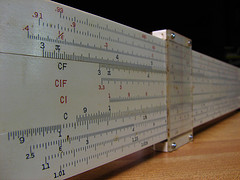helping you to navigate SciEng information
December 21st, 2009 by Eugene Barsky | No Comments »

Here is my newest article – “A Library Journal Club as a Tool for Current Awareness and Open Communication: UBC case study” which oddly sees light online during the last week of 2009.
It is published in a free, open access, Canadian journal – Partnership: the Canadian Journal of Library and Information Practice and Research.
Photo by http://www.flickr.com/photos/svenwerk/
Posted in Main, People | No Comments »
December 15th, 2009 by Eugene Barsky | No Comments »

NYT today has an article on an issue of great importance to all science disciplines – data management. The article – “A Deluge of Data Shapes a New Era in Computing” overviews the new book published by Microsoft researchers – “The Fourth Paradigm: Data-Intensive Scientific Discovery.”
The book is available in full text from Microsoft here – http://research.microsoft.com/en-us/collaboration/fourthparadigm/4th_paradigm_book_complete_lr.pdf
This is a hot issue in science libraries too, as we are trying to understand how to deal with the vast amounts of digital data and whether libraries have a role to play to support, maintain and archive some of this data…
** photo by http://www.flickr.com/photos/nickwheeleroz/
Posted in Astronomy, Atmospheric Science, Chemical and Biological Engineering, Chemistry, Civil Engineering, Earth and Ocean Sciences, General Science, Geography, Main, Materials Engineering, Mathematics, Mechanical Engineering, Mining engineering, Physics, Science - undegraduate classes, Statistics, Wood Sciences | No Comments »
December 3rd, 2009 by Eugene Barsky | No Comments »
Great news for UBC folks:
A new $23.2 million Network of Centres of Excellence (NCE) designed to advance Canada’s position as a global leader in new media, animation and games is to be hosted by the University of British Columbia.
The Graphics, Animation and New Media (GRAND) network will be headquartered at the Centre for Digital Media at Great Northern Way Campus (GNWC), a joint academic collaboration between UBC, Simon Fraser University, Emily Carr University of Art + Design and the British Columbia Institute of Technology.
GRAND will offer student learning and research opportunities and comprise 30 projects clustered around five themes: new media challenges and opportunities; games and interactive simulation; animation, graphics and imaging; and cross-cutting themes of social, legal, economic and cultural perspectives and enabling technologies and methodologies. The network will involve 50 investigators along with collaborating researchers and industry partners.
http://www.science.ubc.ca/news/334
Posted in Main, News, People, Science - undegraduate classes | No Comments »
November 17th, 2009 by Eugene Barsky | No Comments »
Please see below the backbone of our workshop. I don’t use those slides at the workshop, but they are useful as refer-to-later kind of material…
Posted in Main, Teaching | No Comments »
November 12th, 2009 by Eugene Barsky | No Comments »
The newest issue of the Science has a short editorial titled “Becoming a Scientist“.
Personally, I found t his short piece to be very interested and not intuitive…take a look – http://www.sciencemag.org/cgi/content/full/326/5955/916?rss=1
Posted in Astronomy, Atmospheric Science, Chemical and Biological Engineering, Chemistry, Civil Engineering, Earth and Ocean Sciences, General Science, Geography, Main, Materials Engineering, Mathematics, Mechanical Engineering, Mining engineering, Physics, Science - undegraduate classes, Statistics, Wood Sciences | No Comments »
November 5th, 2009 by Eugene Barsky | No Comments »
Last month, UBC Computer Science Professors David Kirkpatrick and Alan Mackworth have been elected as Fellows the Royal Society of Canada (RSC). The RSC, founded in 1882, is Canada’s oldest and most prestigious scholarly organization. Election to the society is the highest honour that can be attained by scholars, artists and scientists in Canada. This year’s new Fellows will be inducted at a ceremony Nov. 28, 2009 in Ottawa.
It is a great honour for UBC Department of Computer Science that half of the UBC Fellows elected this year are from the department. “Alan and David are both brilliant scientists whose hard-won insights have had enormous impact on computer science internationally. Our department has always known that they are national treasures in our midst and we are thrilled that they are being recognized by the Royal Society of Canada with this honour,” says Department Head William Aiello.
Posted in News, People | No Comments »
October 28th, 2009 by Eugene Barsky | No Comments »

Most of us spend our university education taking the standard, required courses, there are more than just the basics out there when it comes to some science classes.
This blog post list some of the most hilarious of them – http://www.onlineuniversities.com/blog/2009/10/100-hilarious-college-courses-that-really-exist/
Personally, I would love to take some of the science classes such as :
The Science of Superheroes: While it might sound like fun and games, this course takes superheroes as a means to teach students real lessons about physics. [U of California Irvine] or Lego Robotics: Legos can help you build more than just that TIE Fighter, they can also be used to make real robots, as this course will show students. [MIT]
** Photo by http://www.flickr.com/photos/jocorvera/
Posted in Amusing stuff, Astronomy, Atmospheric Science, Chemical and Biological Engineering, Chemistry, Civil Engineering, Earth and Ocean Sciences, General Science, Geography, Main, Materials Engineering, Mathematics, Mechanical Engineering, Mining engineering, Physics, Science - undegraduate classes, Statistics, Wood Sciences | No Comments »
October 21st, 2009 by Eugene Barsky | No Comments »

This month, ScienceWatch.com, has listed the ISI ranking in Computer Sciences by citations per paper—among countries that collected 5,000 or more citations during the period—to reveal weighted impact.
http://sciencewatch.com/dr/cou/2009/09octCOM/
“For articles with multiple authors from different nations, each nation receives full, not fractional, citation credit. Essential Science Indicators lists nations ranked in the top 50% for a field over a given period, based on total citations. In Computer Sciences, 79 nations are listed, meaning 158 were surveyed. 27 nations collected at least 5,000 citations during the period. The average citation rate for field of Computer Sciences is 3.14.”
It is great to see Canada listed as #8 (but after Scotland?)…
** photo by http://www.flickr.com/photos/rogersmith/
Posted in Main, News | No Comments »
October 7th, 2009 by Eugene Barsky | No Comments »

A new article today in the Journal of the American Society for Information Science could be of interest to those of you who post their studies to arxiv.org:
A. Haque and P. Ginsparg, “Positional effects on citation and readership in arXiv,” J. Am. Soc. Inf. Sci. Technol., vol. 60, pp. 2203-2218, 2009.
Abstract:
arXiv.org mediates contact with the literature for entire scholarly communities, providing both archival access and daily email and web announcements of new materials. We confirm and extend a surprising correlation between article position in these initial announcements and later citation impact, due primarily to intentional  self-promotion
self-promotion by authors. There is, however, also a pure
by authors. There is, however, also a pure  visibility
visibility effect: the subset of articles accidentally in early positions fared measurably better in the long-term citation record. Articles in astrophysics (astro-ph) and two large subcommunities of theoretical high energy physics (hep-th and hep-ph) announced in position 1, for example, respectively received median numbers of citations 83%, 50%, and 100% higher than those lower down, while the subsets there accidentally had 44%, 38%, and 71% visibility boosts. We also consider the positional effects on early readership. The median numbers of early full text downloads for astro-ph, hep-th, and hep-ph articles announced in position 1 were 82%, 61%, and 58% higher than for lower positions, respectively, and those there accidentally had medians visibility-boosted by 53%, 44%, and 46%. Finally, we correlate a variety of readership features with long-term citations, using machine learning methods, and conclude with some observations on impact metrics and the dangers of recommender mechanisms.
effect: the subset of articles accidentally in early positions fared measurably better in the long-term citation record. Articles in astrophysics (astro-ph) and two large subcommunities of theoretical high energy physics (hep-th and hep-ph) announced in position 1, for example, respectively received median numbers of citations 83%, 50%, and 100% higher than those lower down, while the subsets there accidentally had 44%, 38%, and 71% visibility boosts. We also consider the positional effects on early readership. The median numbers of early full text downloads for astro-ph, hep-th, and hep-ph articles announced in position 1 were 82%, 61%, and 58% higher than for lower positions, respectively, and those there accidentally had medians visibility-boosted by 53%, 44%, and 46%. Finally, we correlate a variety of readership features with long-term citations, using machine learning methods, and conclude with some observations on impact metrics and the dangers of recommender mechanisms.
** Photo by http://www.flickr.com/photos/easternblot/ – “Paul Ginsparg shows that everyone submits their paper to ArXiv *just* after the submission deadline so they’ll be the first on the front page the next day”
Posted in Astronomy, Atmospheric Science, Chemical and Biological Engineering, Chemistry, Civil Engineering, Earth and Ocean Sciences, General Science, Geography, Main, Materials Engineering, Mathematics, Mechanical Engineering, Mining engineering, Physics, Science - undegraduate classes, Statistics, Uncategorized | No Comments »
October 1st, 2009 by Eugene Barsky | No Comments »
Those of us, who teach or use Google or Google Scholar (GS) might find the most recent Peter Jacso’s piece on Google Scholar to be of interest – http://www.libraryjournal.com/article/CA6698580.html?&rid=1105906703&source=title
Please be very careful using this tool. We talk about the perils of GS and compare it with Compendex and Web of Science in our Google workshops.
We ourselves saw those problems almost five years ago, and they are still not corrected:
Giustini D, & Barsky E. A look at Google Scholar, PubMed and Scirus: comparisons and recommendations . J Can Health Libr Assoc 2005, 26(3): 85-89.
Posted in Astronomy, Atmospheric Science, Chemical and Biological Engineering, Chemistry, Civil Engineering, Earth and Ocean Sciences, General Science, Geography, Main, Materials Engineering, Mathematics, Mechanical Engineering, Mining engineering, Physics, Science - undegraduate classes, Statistics, Teaching, Wood Sciences | No Comments »
« Newer Posts - Older Posts »





 self-promotion
self-promotion by authors. There is, however, also a pure
by authors. There is, however, also a pure 